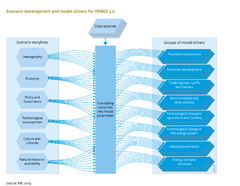Drivers/Model drivers: Difference between revisions
< Drivers
Jump to navigation
Jump to search
No edit summary |
Oostenrijr (talk | contribs) No edit summary |
||
| Line 4: | Line 4: | ||
|Reference=FAO, 2013a; Bruinsma, 2003; Alexandratos and Bruinsma, 2012; Bouwman et al., 2013b; Rohwer et al., 2007; Bouwman et al., 2005; Klein Goldewijk et al., 2010; Rogner, 1997; Mulders et al., 2006; | |Reference=FAO, 2013a; Bruinsma, 2003; Alexandratos and Bruinsma, 2012; Bouwman et al., 2013b; Rohwer et al., 2007; Bouwman et al., 2005; Klein Goldewijk et al., 2010; Rogner, 1997; Mulders et al., 2006; | ||
|Description=<h2>Model drivers</h2> | |Description=<h2>Model drivers</h2> | ||
Direct model drivers are inferred from the scenario drivers and used in setting the parameter values in IMAGE 3.0. The start values are estimated from the literature and data, and future changes in values are inferred from the narratives and scenario drivers. The resulting parameter values are used as input for different parts of IMAGE 3.0. A list of most important model drivers, their source and their use in [[Framework overview]]is given in | Direct model drivers are inferred from the scenario drivers and used in setting the parameter values in IMAGE 3.0. The start values are estimated from the literature and data, and future changes in values are inferred from the narratives and scenario drivers. The resulting parameter values are used as input for different parts of IMAGE 3.0. A list of most important model drivers, their source and their use in [[Framework overview]]is given in the table of drivers below. | ||
===Example of a model driver: technological change in agriculture=== | ===Example of a model driver: technological change in agriculture=== | ||
Revision as of 12:55, 24 June 2014
Parts of Drivers/Model drivers
| Projects/Applications |
| Models/Databases |
| Relevant overviews |
| Key publications |
| References |
